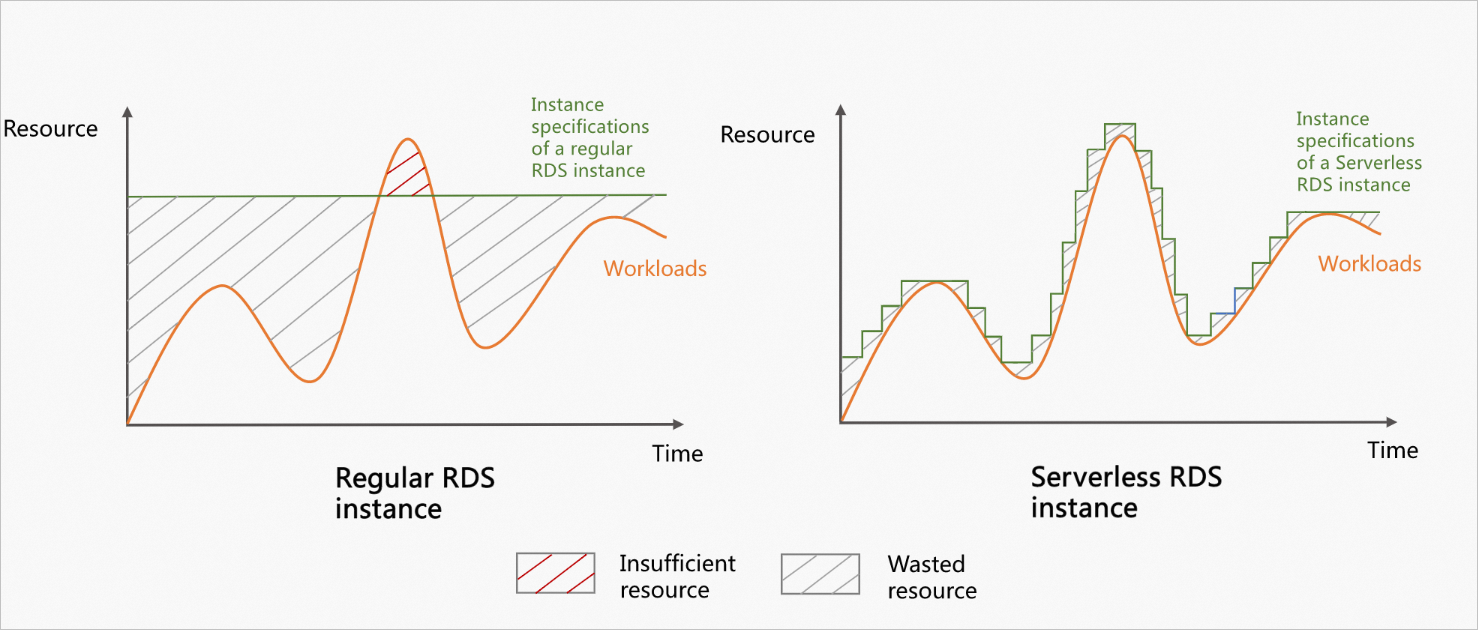You can also join the DingTalk group 41925003105 for consultation, communication, and feedback.
Official launch
Serverless RDS instances are officially launched on March 20, 2023. You can create a serverless RDS instance in the ApsaraDB RDS console.
Serverless RDS instances are available in the China (Hong Kong) and Singapore regions.
You can create a serverless RDS instance that runs SQL Server 2016 SE, SQL Server 2017 SE, or SQL Server 2019 SE on RDS High-availability Edition.
If you use a RAM user to create a serverless RDS instance, the AliyunRDSFullAccess policy must be attached to the RAM user. For more information, see Use RAM for resource authorization.
Service level agreement (SLA) commitments are not applicable to your serverless RDS instance or to the availability and liability of any relevant services. Alibaba Cloud shall not be liable for the adverse impacts of your use of serverless RDS instances and relevant services.
Introduction
Serverless RDS instances allow you to quickly and independently scale computing resources to adapt to fluctuating workloads. These benefits simplify rightsizing your RDS instances, helping you reduce costs and improve efficiency.
The following figure compares the rate of resource utilization between a regular RDS instance and a serverless RDS instance with fluctuating workloads.

Referring to the preceding figure, we can obtain the following conclusions:
Architecture

Benefits
Low cost: Serverless RDS instances do not rely on other infrastructure and services and can provide stable and efficient data storage and access services. This deployment model is ideal for startups and scenarios that want to run workloads immediately after resources are created. You are charged only for the resources that you use based on the pay-as-you-go billing method.
Auto scaling of computing resources: The computing resources that are required for read and write operations can be automatically scaled without human intervention. This greatly reduces O&M costs and risks of human errors.
Fully managed and maintenance-free services: Serverless RDS instances are fully managed by Alibaba Cloud, allowing you to focus on developing your application instead of O&M operations, such as system deployment, scaling, and alert handling. The O&M operations are performed in the background and are transparent at the service layer.
High availability: The serverless RDS instance runs in high-availability mode.
Limits
Serverless RDS instances do not support the following features: time zone change, character set change, self-managed domain connection, transparent data encryption (TDE), SSL encryption, cloud disk encryption, major engine version upgrade, or minor engine version update.
Although serverless RDS instances use the pay-as-you-go billing method, serverless RDS instances are billed based on RDS Capacity Units (RCUs). Therefore, you cannot change the billing method of serverless RDS instances from pay-as-you-go to subscription.
Read-only serverless RDS instances are not supported. You can create a primary RDS instance that runs RDS Cluster Edition and create read-only RDS instances for the primary RDS instance. For more information, see Create an ApsaraDB RDS for SQL Server instance and Overview of read-only ApsaraDB RDS for SQL Server instances.
You cannot create system admin accounts and host accounts on a serverless RDS instance. For more information, see Accounts and permissions.
Scenarios
Scenarios in which off-peak hours are significant, such as development and testing environments
Software as a service (SaaS) scenarios, such as website building of small and medium-sized enterprises
Educational scenarios, such as teaching and student experiments
Scenarios that handle inconsistent and unpredictable workloads, such as IoT and edge computing
Scenarios in which services are changing or unpredictable
Scenarios in which intermittent scheduled tasks are involved
Individual developers
References
You can create a serverless RDS instance. For more information, see Create a serverless ApsaraDB RDS for SQL Server instance.
The system automatically adjusts the RCUs of the serverless RDS instance within the range that you specified based on workloads. You can also manually change the scaling range of RCUs based on your business requirements. For more information, see Change the scaling range of RCUs.
If the storage capacity of your serverless RDS instance no longer meets your business requirements, you can manually expand the storage capacity. For more information, see Expand storage capacity.
 Elastic Compute Service (ECS)
Elastic Compute Service (ECS)
 Container Compute Service (ACS)
Container Compute Service (ACS)





























